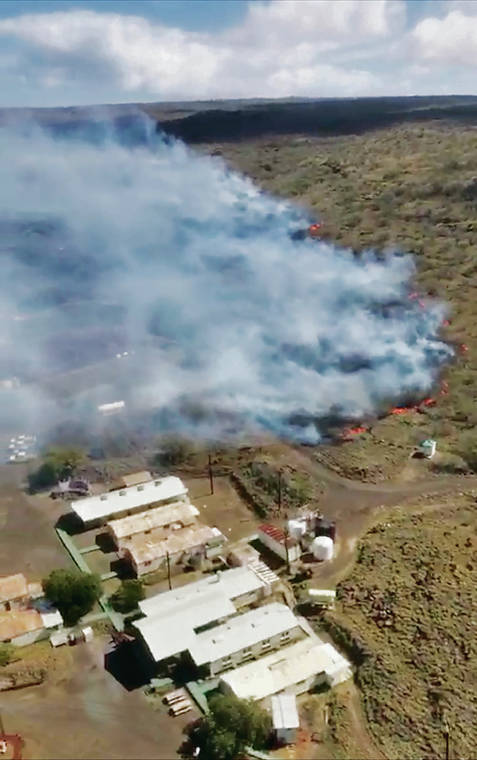Emergency funding of at least $1 million is being sought from the state Legislature following a brush fire on Kahoolawe estimated to be the largest to strike the island in decades.
The Kahoolawe Island Reserve Commission is working with state Sen. J. Kalani English (D, East Maui- Molokai-Lanai-Kahoolawe) to introduce the emergency appropriation.
The fire, which started Feb. 22 and burned and then smouldered for nearly a week and a half, blackened 9,000 acres on the island’s western side.
While KIRC’s base camp at Honokanaia barely escaped the fire, several storage buildings higher up on the island were destroyed. Those structures housed vehicles, tools, equipment and supplies.
The magnitude and intensity of the blaze were fueled by invasive grasses and exacerbated by the fact that no firefighting took place on the island for fear of the unexploded ordnance left in the ground following 50 years of military target practice.
Fortunately, the native plantings and restoration work accomplished over the last decade and a half were largely spared, protected at the top of the island by a region of barren hardpan left by erosion caused by 200 years of grazing operations.
Officials don’t know the cause of the blaze and might never know because the rain that helped extinguish the fire may have washed away evidence of its origin.
Michael Nahoopii, KIRC executive editor, said his staff will search for clues of the cause when they visit the island next weekend to conduct a full assessment of the fire’s impact.
Nahoopii said his troops are now compiling food and supplies for a 10-day mission that will deploy drones to map the extent of the fire, sift through the remains of burned property and assess the vulnerability of the base camp, among other things.
“We’ve got to get out there and reopen that camp,” he said.
Nahoopii said on that first day of the fire, Feb. 22, he wasn’t worried after the Maui Fire Department reported no major damage from a 100-acre blaze that appeared to be contained by the island’s main road, which acted as a firebreak.
The next day, the wind shifted, however, and strong trades pushed the flames across the road and to the south to sweep over the upland storage area known as Squid. The fire also overwhelmed the Protect Kaho‘olawe ‘Ohana camp at Ahupu.
The island burned all week, but by Feb. 28 rain was slowly dousing the fire. Then, by Tuesday, two small fires restarted from the smouldering embers, and helicopters working for the Maui office of the state Division of Forestry and Wildlife conducted water drops and extinguished them in an hour and a half.
Destroyed were three new all-terrain vehicles, four trucks, two watercraft, a chipper, water catchment tanks and other equipment used in the island’s restoration, plus pallets of construction lumber and irrigation tubing and supplies. Preliminary loss estimates include $500,000 for vehicles, equipment and supplies and $500,000 for the buildings.
The last major fire on Kahoolawe was in 2003, while the Navy was clearing bombs on the island. A workforce of about 500 fought the fire, along with helicopters, to keep the burned acreage to about half the size of this year’s blaze, Nahoopii said. Previously, grazing kept the grasses short and less susceptible to fire.
While the damage from the latest fire represents a significant setback, the fire does bring opportunities, Nahoopii said. The fire blackened thousands of acres of invasive buffelgrass the KIRC was already wondering how to get rid of.
That grass, much of it grown from seed blown to the island from nearby Maui, attracts mice and burns a lot easier than native grasses, he said.
Nahoopii said he’s hoping to reseed the burned area with native seed or find a ground cover that is more fire-resistant. Among the assignments for volunteers set to travel to the island next week is to collect seeds from unburned areas for use in reseeding the blackened slopes.
“We have a chance to transform the face of the island and to protect its future,” he said.
In the meantime the Protect Kaho‘olawe ‘Ohana sent a team to the island Thursday to try to recover what can be saved from the Ahupu camp, the base of operations for the group’s project to create a trail around the perimeter of the island. Damage to the Ahupu camp could amount to as much as $10,000, the group said.
The KIRC team is also preparing a preliminary draft recovery plan for its base camp at Honokanaia. One of the goals next week is to create larger fire buffers around the camp and to cut back vegetation in the camp’s interior.
On Friday, state Rep. Lynn DeCoite (D, Lanai- Molokai-Molokai-East Maui) introduced a House resolution urging all state departments and agencies to cooperate and help KIRC with technical, engineering or logistical support.
The Senate is expected to take up the emergency appropriation in the coming days. The request comes in the same year in which KIRC is already asking for $500,000 to support ongoing restoration efforts on the island, plus money for two additional staff positions.
KIRC has started an online fundraising campaign to help replace equipment needed for day-to-day restoration activities on the island, including staff- directed and volunteer- supported planting and watering efforts.
The page is at 808ne.ws/kahoolaweresponsefund Opens in a new tab.
The Protect Kaho‘olawe ‘Ohana has started one as well: a GoFundme.com page through its supporting nonprofit, Kohe Malamalama o Kanaloa. Funds will replace such things as chain saws, weed whackers, hand tools and field kitchen supplies.
The page is at 808ne.ws/kahoolawefire Opens in a new tab.

